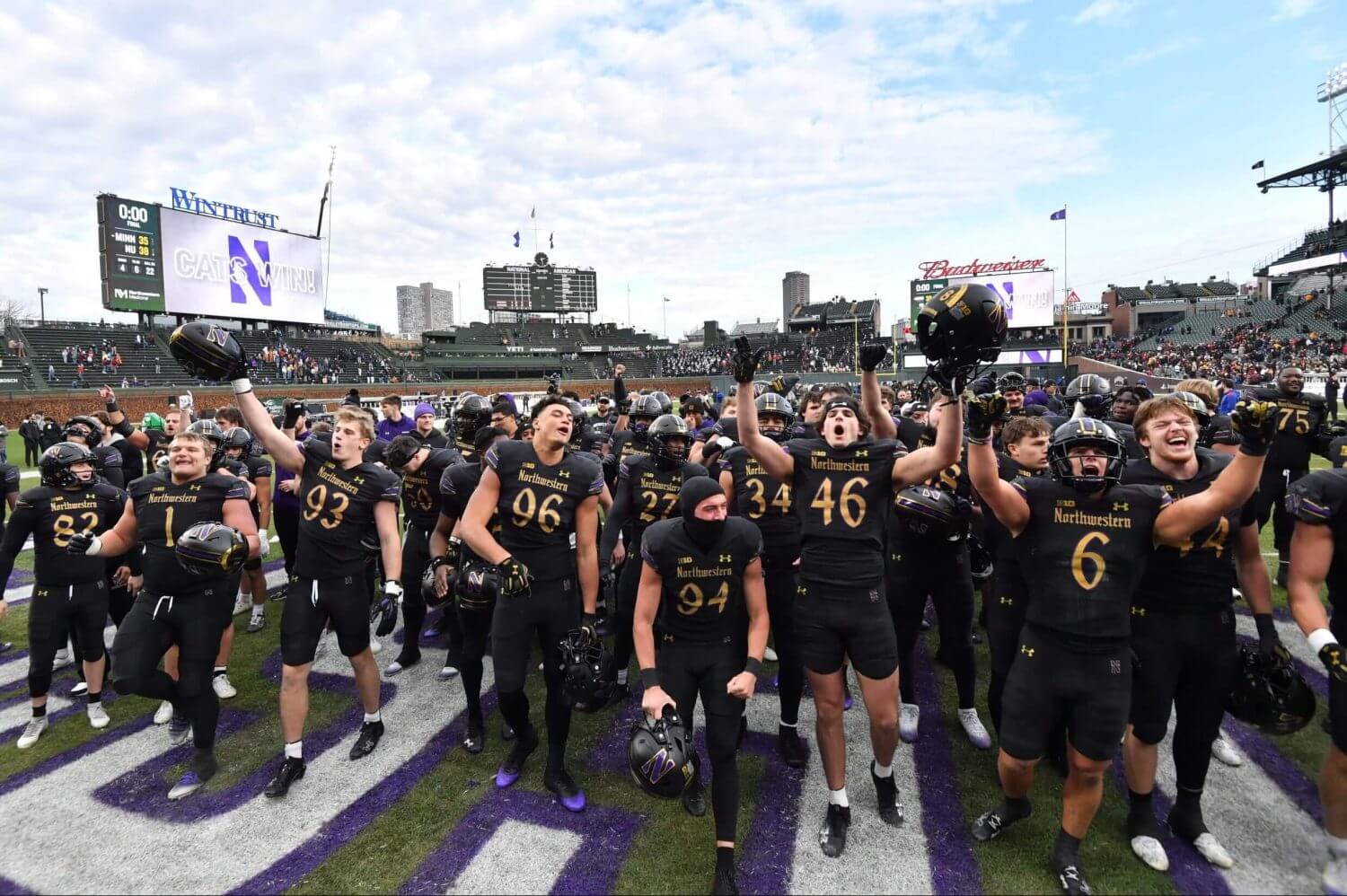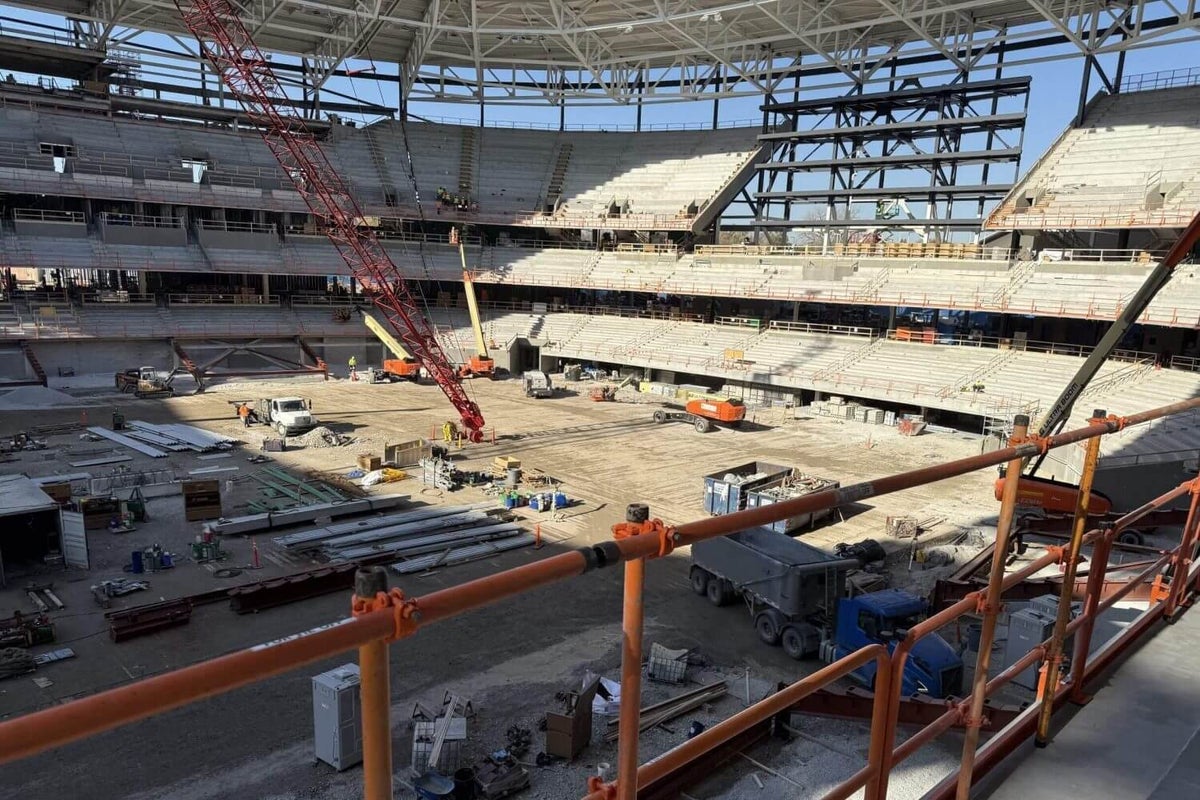Editor’s note: This article is part of our College Football Stadium Rankings series, highlighting the most interesting venues across the country.
EVANSTON, Ill. — Pat Ryan Jr. believes killing the nosebleed section of Northwestern’s new stadium will create the best in-person viewing experience not just in the Big Ten but at every level of the sport.
“This will be the best place to see a football game in America, college or NFL,” said Ryan Jr., whose family is funding most of Northwestern’s $850 million stadium project.
The new Ryan Field will be the first brand-new stadium for a power-conference college football program since Baylor’s McLane Stadium debuted in 2014. Built on the same location as its predecessor, Ryan Field offers 320,000 more square feet for fans but 12,500 fewer seats, dropping capacity from 47,500 to 35,000. The more vertical design moves every seat — all of which are padded and purple — closer to the playing surface than all but its courtside counterparts in basketball arenas.
The Big Ten’s smallest institution hopes to claim a true home-field advantage and reimagine the in-stadium experience to compete with television. Ryan, who oversees every aspect of the project as the CEO of Ryan Sports Management, chose to focus on comfort and sight lines over capacity. To him, there’s more risk in a safe upgrade than trying for something unprecedented.
“Our bet is we’re doing it different, but we’re doing it very intentionally different,” Ryan said. “If we’re right, hopefully, it’ll be helpful to others. And if we’re wrong, well, it’s one of a kind.”
The television-viewing experience has prompted new NFL stadiums to trim capacity by 20 to 25 percent from previous generations to bolster the value of attending in person, according to Marc Ganis, the co-founder and managing director of Sportscorp Ltd., a consulting firm that has helped drive more than two dozen sports facility projects in the U.S. and China. But in Northwestern’s case, Ganis said, the funding model is different, as is the focus.
“It is unusual,” said Ganis. “A significant part of the funding is coming from the Ryan family. They wanted their gift to be something that would be very well received for generations to come, and so they wanted to make the experience as a positive for the fans.
“Because let’s face it: Northwestern football has not always been competitive. So the more the experience is positive, then even if the games aren’t great and the team’s not great, people still will want to come back.”
The original Ryan Field debuted as Dyche Stadium in 1926, and by 2023, it didn’t look a day older than 97. It wasn’t as well maintained as the Big Ten’s other century-old football cathedrals. The towers that anchored the stadium’s west side provided some charm, but they were hardly iconic. The upper deck and press box were located high enough to see Lake Michigan more than a mile away, and the playing field seemed just as far.
Northwestern officials identified three renovation options. For $280 million, they could have shored up the structural issues and added some skyboxes. At a price tag of around $480 million, the stadium could have gotten a major upgrade, similar to Kansas’ recent renovation, but Ryan said it would not have stood out among other Power 4 stadiums.
“The renovation was like, spend a lot to get almost no change,” Ryan Jr. said. “You’d extend the life, but it wouldn’t modernize it in any meaningful way.”
The third option was a new stadium. In the Chicagoland area, that wasn’t going to come cheap. But for the Ryan family, which has donated billions to the university to fund athletics facilities, a nanotechnology building and a performing arts center among other projects, this was another chance to transform Northwestern for generations.
No person was more responsible for Northwestern’s athletic profile than Ryan Sr. During a six-year run from 1976 through 1981, the football team went 3-62-1. Ryan pushed his fellow trustees to invest in athletics, and in 1995, after 23 consecutive losing seasons, the Wildcats won the Big Ten and played in the Rose Bowl. Three decades later, Northwestern sees its new facility as pivotal in attracting football talent and competing for championships.
“It maintains the standard of Northwestern,” athletic director Mark Jackson said. “It’s a responsibility we take really seriously. It will certainly provide advantages we’ve never had before.”

A model shows what the exterior of the new Ryan Field will look like once completed. (Scott Dochterman for The Athletic)
Donning a hard hat, gloves and a construction vest, Ryan was eager to show off the stadium’s progress in mid-November. His construction crews hustled alongside Chicago’s steelworkers to advance this project before winter settled in. A topping-out ceremony took place after the final beam’s installation this month, with more than 400 guests and dignitaries in attendance.
While standing on the upper deck, Ryan pointed at a folded boom lift inside the end zone. The crane felt close enough to touch, even from the stadium’s highest point. No matter where a person sat in what is termed the loft level, the field view was sharp.
“When I say this will be the best place in America to watch a football game,” he said, “this is what I mean.”
The new Ryan Field will have four seating levels, all set up so that fans can see the field cleanly without binoculars. Only 48 feet separate the lower-bowl stands from the field, and then the seating slope changes dramatically. The club living room seats and suites are 90 and 110 feet from the field, respectively. The farthest seat in the upper deck is only 136 feet from the FieldTurf playing surface, which is nearly half the distance from the field as Notre Dame Stadium’s upper levels. The same level of seating at Michigan Stadium is 253 feet from the field.
In fact, every seat at Ryan Field is closer to the field than corresponding sections at the United Center, home of the Bulls and Blackhawks, or the Intuit Dome, the Clippers’ year-old home arena. There are only 18 rows of seats in the upper deck.
“By getting rid of these last set of seats, which are the most expensive to build, the hardest to sell, lowest price, lowest fan satisfaction, it allows you to make the experience for everybody else more magical,” Ryan said.
“Think of it as the death of the nosebleed.”
Canopies weighing as much as 250,000 pounds per panel protect all 35,000 seats from the elements. The stadium boasts four premium club areas, each one constructed for different sets of fans: a field-level club with an up-close look at the team’s entrance to the field set adjacent to the postgame news conference room, a corporate club for the Chicago business community, a loft club area for young alums and a student hall located next to the plaza. There is also free end zone seating for 2,000 students, about a quarter of Northwestern’s undergraduate enrollment.
“The new stadium will be state-of-the-art, fabulous,” said 1966 Northwestern graduate Peggy Marte, who has held season tickets since way before the mid-1990s resurgence. “It’s gorgeous. I think we’re really lucky.”
But beyond fan amenities, Ryan and Northwestern athletics are trying to foster deeper community with the university, the city of Evanston and the entire North Shore. It was a difficult and contentious process to obtain zoning approval for outside events, which led to a late start on construction. Many Evanston residents disapproved of anything more than football games in their quaint suburb.
“When this is all done,” Ganis said, “I would say that Northwestern and the region owe them an incredible debt.”
The facility will host up to six concerts each year in addition to Wildcats football games and other Northwestern events, and more than 200,000 square feet outside the stadium will be designated into four plazas inside a secure perimeter. The stadium shifted 25 degrees on its lot to allow for more green space, and the newly created plazas will hold summer and holiday festivals with street carts and food from area restaurants. Northwestern plans to market the stadium for corporate events and conventions and hopes Ryan Field could attract NCAA championships in soccer and lacrosse. Evanston Township High School will also play football games there.
“There’s a whole set of programming around there that is indicative of our commitment to the community, of the investment and making this a year-round destination for people,” Jackson said. “We can’t wait to show it off.”

The Wildcats finally broke through at Wrigley Field with a win over Minnesota on Saturday. (Patrick Gorski / Imagn Images)
From the ivy covering the brick outfield wall to the old-fashioned scoreboard, Wrigley Field on a sunny day is a portal to Chicago’s past. Northwestern has taken on a bigger presence at the Cubs’ iconic ballpark the last 15 years. First, it was for select football games. The last two seasons, it was out of necessity.
On a mid-November afternoon, Northwestern and Michigan fans filled Wrigley Field for the first of two Wildcats football “home” games this season. Wolverines significantly outnumbered Wildcats, which has become the norm for Northwestern against Big Ten opponents at Wrigley and often at the old Ryan Field. Their nearby Big Ten foes regularly took up at least one-third of the seats at Ryan Field. When the Wildcats hosted games at Wrigley, teams like Michigan, Iowa and Ohio State doubled up Northwestern’s contingent.
“You’re being generous,” said Ganis, a Chicagoan and Northwestern alum. “Two-thirds.”
When the new stadium becomes operational in time for next season, the Wrigley visits will end. The Wildcats’ 38-35 win against Minnesota on Saturday was their first victory in eight Wrigley games, a perfect way to cap the experience. Now, they want to claim a home-field advantage and put together a team capable of defending it.
“What I’m responsible for is making sure that we put a team on that field that ultimately makes it come to life,” Northwestern coach David Braun said. “I’ll challenge people in the Chicagoland area that have got young kids and they’re not sure where their allegiance lies that want to experience Big Ten football in the best stadium in the world for football. Why would you not want to be a part of that and be wearing purple while you do it? I have full faith in the fact that we are going to turn new Ryan Field into a huge home-field advantage. I have no doubt in my mind.”
Northwestern sees an opportunity to carve its own space in the crowded Chicago sports market. For the first time, Northwestern’s football facilities will match the reputation of the university’s academic facilities and perhaps exceed those of some Big Ten competitors.
“When you think about the history of Big Ten football in Chicago, they’ve never had a premium product,” Jackson said. “This is the first time in history that’s ever happened, and we get to steward that and shape that. That’s a tremendous responsibility.
“We don’t want to just survive in the Big Ten. We want to thrive in it. And we think the stadium is a big piece to that puzzle.”
The College Football Stadium Rankings series is part of a partnership with StubHub. The Athletic maintains full editorial independence. Partners have no control over or input into the reporting or editing process and do not review stories before publication.

